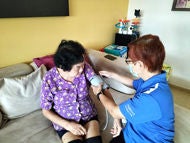What is - Fibromyalgia
What is fibromyalgia?
Fibromyalgia is a chronic medical condition which presents as widespread pain and tenderness throughout the body.

Fibromyalgia is a long-term condition characterised by widespread pain, fatigue and cognitive symptoms. This pain occurs in various areas of the body — both above and below the waist, often on both sides.
The pain associated with fibromyalgia is often chronic and has been described as a constant, dull ache.
Fibromyalgia is generally estimated to impact approximately 2-5% of the population, with a higher prevalence observed in women. A survey of Singaporean rheumatologists found that most consider fibromyalgia an independent condition different from other pain syndromes.
Symptoms of Fibromyalgia
What are the symptoms of fibromyalgia?
- Chronic, widespread pain: Thought to be linked to abnormal pain processing in the central nervous system, making individuals increasingly sensitive to stimuli
- Fatigue: Often results from disrupted sleep patterns, which are common in fibromyalgia due to ongoing pain and discomfort
- Muscle and joint stiffness: Accompanied by tenderness to touch and numbness or tingling, likely due to abnormal sensory processing
- Cognitive symptoms ("fibro fog"): Involves difficulties with concentration, clear thinking and memory
- Heightened sensitivity: Increased sensitivity to light, noise, odours and temperature, possibly due to an overactive nervous system
- Digestive issues: Though the exact link is unclear, these issues may involve disturbances in the gut-brain axis
When should you see a doctor?
If you have experienced persistent, widespread pain, fatigue and tiredness for three months or more, consider consulting a doctor.
Fibromyalgia - How to prevent
How is fibromyalgia prevented?
Fibromyalgia cannot be prevented as the exact causes are not fully understood. However, certain lifestyle approaches may help reduce the risk or manage symptoms:
- Maintain regular physical activity: Engaging in gentle exercises such as walking, swimming or stretching can help keep muscles flexible and reduce pain sensitivity.
- Manage stress levels: Practising stress management techniques, such as mindfulness, meditation or deep breathing, may help minimise stress and its impact on the body.
- Prioritise good sleep hygiene: Establishing a consistent sleep routine and creating a restful environment can support better sleep quality and reduce fatigue.
- Adopt a balanced diet: Eating a nutritious diet can support overall health, potentially helping to reduce inflammation and support energy levels.
- Stay socially connected: Building a strong support network can help reduce feelings of isolation and may contribute to improved mental well-being, which is beneficial in managing symptoms.
- Avoid overexertion: Balancing physical and mental activities can prevent strain, which may reduce the risk of exacerbating symptoms in those at risk of fibromyalgia.
Fibromyalgia - Causes and Risk Factors
What causes fibromyalgia?
- Abnormal pain processing in the central nervous system: Individuals with fibromyalgia may have heightened sensitivity to pain due to abnormal pain signalling in the brain and spinal cord.
- Physical or emotional trauma: Traumatic events, such as accidents or prolonged psychological stress, can trigger or worsen fibromyalgia symptoms.
- Infections and illnesses: Certain viral infections and illnesses have been linked to the onset of fibromyalgia in some individuals.
What are the risk factors for fibromyalgia?
- Gender: Fibromyalgia is more common in women than men, though the reasons for this are not fully understood.
- Family history: Individuals with a family history of fibromyalgia or similar conditions may have a higher likelihood of developing it.
- Other conditions: Conditions such as osteoarthritis, rheumatoid arthritis and lupus increase the risk of fibromyalgia.
- Stress and mental health issues: High levels of stress, anxiety or depression may increase susceptibility to fibromyalgia by affecting how the body processes pain.
What are the complications of fibromyalgia?
Although fibromyalgia typically does not lead to life-threatening complications, it can significantly impair a person's quality of life. Some common complications include:
- Diminished quality of life: Individuals with fibromyalgia often experience reduced quality of life due to ongoing pain, fatigue and the impact on daily activities. This can lead to emotional distress, social isolation and difficulty maintaining a normal routine.
- Comorbid psychological conditions: Fibromyalgia frequently coexists with psychological conditions such as depression and anxiety. Managing chronic pain often takes a toll on mental well-being.
- Decreased physical functioning: The widespread pain and fatigue associated with fibromyalgia can limit physical functioning, making it challenging to perform everyday tasks. This may lead to a more sedentary lifestyle. People with fibromyalgia are twice as likely to be admitted to the hospital compared to those without the condition.
- Impaired work productivity: Fibromyalgia can affect productivity and may lead to missed workdays. The condition may also require workplace accommodations to help individuals manage their symptoms.
- Medication side effects: Some individuals with fibromyalgia may need medications to manage symptoms and these medications can have side effects. Balancing medications to alleviate symptoms without adverse effects can be challenging.
Diagnosis of Fibromyalgia
How is fibromyalgia diagnosed?
Diagnosing fibromyalgia can be complex, as there is no single test to confirm the condition. Doctors typically use a combination of physical examination, medical history and symptom assessment to make a diagnosis.
Here are the common steps involved:
- Symptom evaluation: A doctor will ask about symptoms, focusing on chronic, widespread pain, fatigue and any cognitive difficulties experienced over the past three months or more. Symptoms should not be attributable to any other condition.
- Physical examination: During a physical examination, the doctor may check for areas of tenderness or heightened pain response, often referred to as tender points, to help identify the characteristic widespread pain of fibromyalgia.
- Ruling out other conditions: To ensure an accurate diagnosis, doctors may conduct blood tests or imaging studies to exclude other conditions that could cause similar symptoms, such as rheumatoid arthritis, lupus or thyroid disorders.
- Assessment of additional symptoms: Fibromyalgia often presents with accompanying symptoms like sleep disturbances, digestive issues and heightened sensitivity to sensory stimuli. Doctors may assess these additional symptoms to support the diagnosis.
- Using diagnostic criteria: Many doctors use criteria from the American College of Rheumatology, which focuses on symptom severity and duration, to determine if a patient meets the requirements for a fibromyalgia diagnosis.
- Widespread pain index (WPI): This assesses pain in specific areas of the body. A certain number of painful areas must be identified to support a diagnosis.
- Symptom severity scale (SSS): This evaluates the intensity of other symptoms such as fatigue, sleep disturbances and cognitive issues, rating them to determine their impact on daily life.
- Duration of symptoms: Symptoms must be persistent, typically lasting three months or longer, to meet diagnostic criteria.
- Exclusion of other conditions: The criteria emphasise that similar symptoms must not be explained by other medical conditions, helping to ensure an accurate diagnosis.
Treatment for Fibromyalgia
How is fibromyalgia treated?
There is currently no cure for fibromyalgia, but various treatments and lifestyle measures can help manage symptoms and improve quality of life. Common approaches include:
- Medication: Doctors may prescribe medications to manage pain, improve sleep and reduce fatigue. Common options include pain relievers, certain antidepressants and anti-seizure drugs to help ease symptoms.
- Physical therapy: Targeted exercises, stretching and muscle-strengthening activities can help improve mobility, reduce pain and increase muscle strength.
- Cognitive behavioural therapy (CBT): CBT is a form of talk therapy that helps individuals manage the impact of chronic pain by teaching them coping strategies and addressing negative thought patterns.
- Exercise: Regular low-impact aerobic activities, such as walking, swimming or cycling, can reduce pain sensitivity and improve overall well-being.
- Stress management: Techniques like mindfulness, meditation and deep breathing exercises can help manage stress, which may alleviate symptoms.
- Good sleep hygiene: Creating a consistent sleep routine and maintaining a restful environment can improve sleep quality, reducing fatigue and promoting recovery.
- Dietary adjustments: A balanced diet rich in nutrients may support overall health, potentially reducing inflammation and boosting energy levels.
- Support groups: Joining a support group can provide emotional relief, shared experiences and practical advice for managing fibromyalgia.
- Alternative therapies: Some people find relief through acupuncture, massage or other complementary therapies that may help reduce pain and promote relaxation.
FAQs on Fibromyalgia
Fibromyalgia is commonly considered a chronic condition, but individual experiences vary. Some people may experience symptom improvement or remission periods, especially with practical management strategies.
There is no conclusive evidence linking vaccinations to the onset of fibromyalgia. Research does not support a direct causative relationship between vaccines and fibromyalgia.
While no specific diet is proven to cure fibromyalgia, some people find relief by avoiding certain foods or adopting an anti-inflammatory diet.
References
Ruschak, I., Montesó-Curto, P., Rosselló, L., Aguilar Martín, C., Sánchez-Montesó, L., & Toussaint, L. (2023). Fibromyalgia Syndrome Pain in Men and Women: A Scoping Review. Healthcare, 11(2), 223. https://doi.org/10.3390/healthcare11020223
Arshad, A., & Ooi, K. K. (2007). Awareness and Perceptions of Fibromyalgia Syndrome: A Survey of Southeast Asian Rheumatologists. JCR: Journal of Clinical Rheumatology, 13(2), 59. https://doi.org/10.1097/01.rhu.0000260494.29921.9e
Fibromyalgia. healthdirect. (2023, April 21). https://www.healthdirect.gov.au/fibromyalgia U.S. Department of Health and Human Services. (2024, September 11). Fibromyalgia.
National Institute of Arthritis and Musculoskeletal and Skin Diseases. https://www.niams.nih.gov/health-topics/fibromyalgia
Ablin, J. N. (2021). Genetics of fibromyalgia. Fibromyalgia Syndrome, 109–118. https://doi.org/10.1007/978-3-030-78638-0_10
Contributed by
The information provided is not intended as medical advice. Terms of use. Information provided by SingHealth.
Get to know our doctors at SingHealth Hospitals in Singapore.
Get to know our doctors at SingHealth Hospitals in Singapore. here.





















